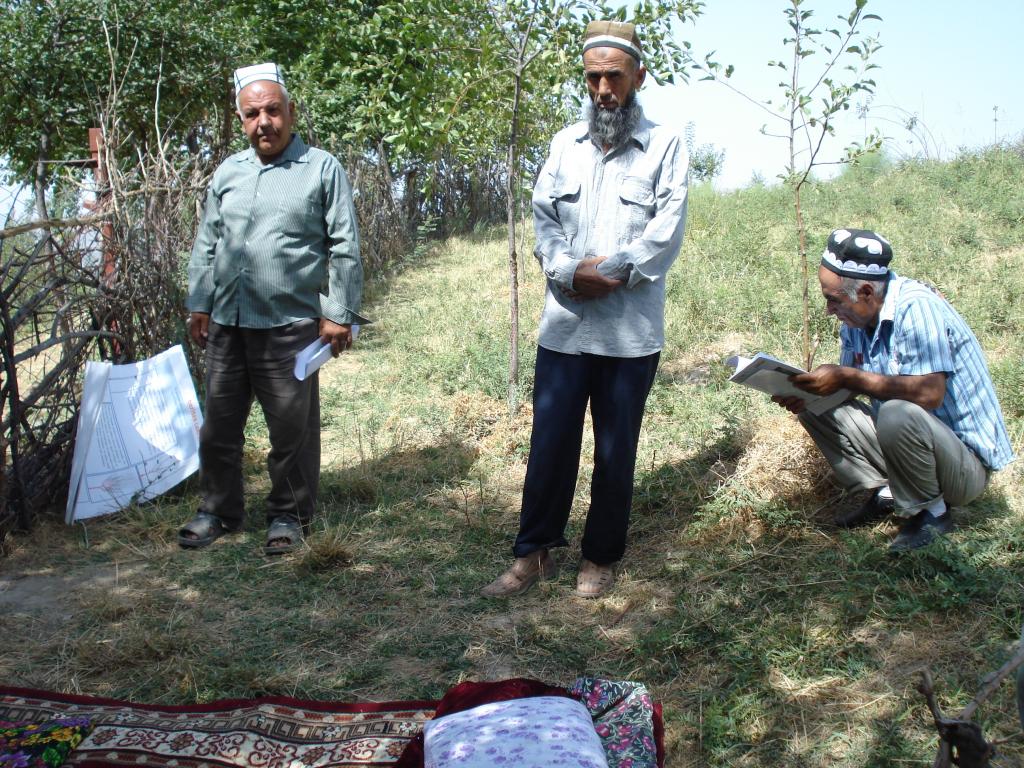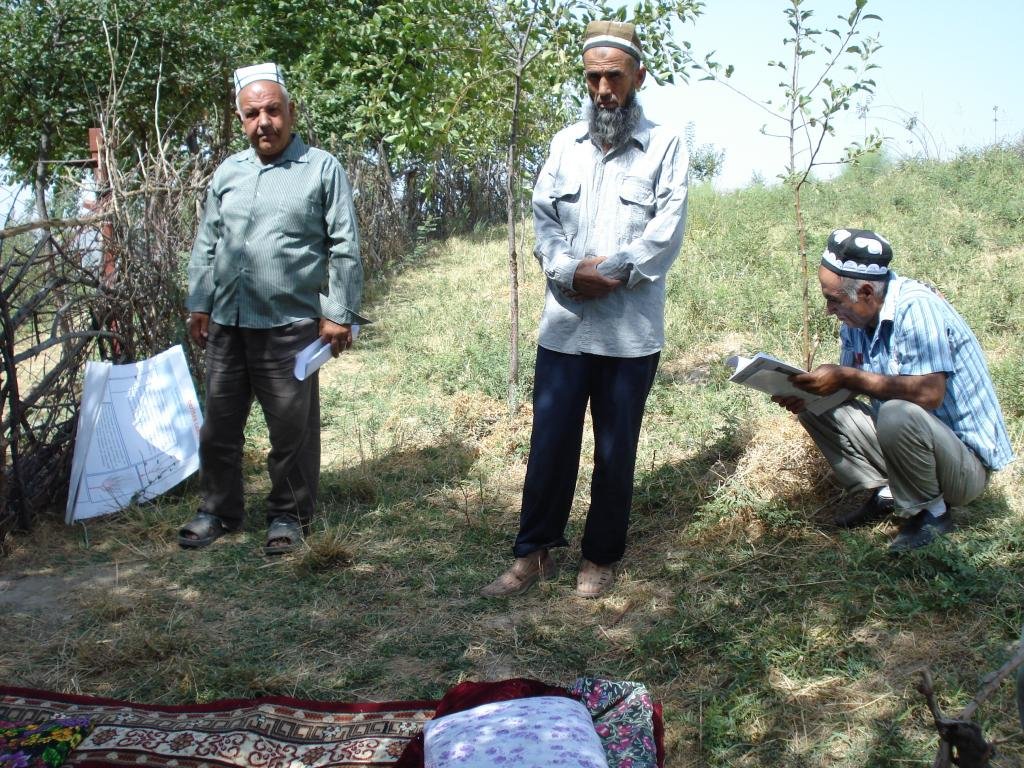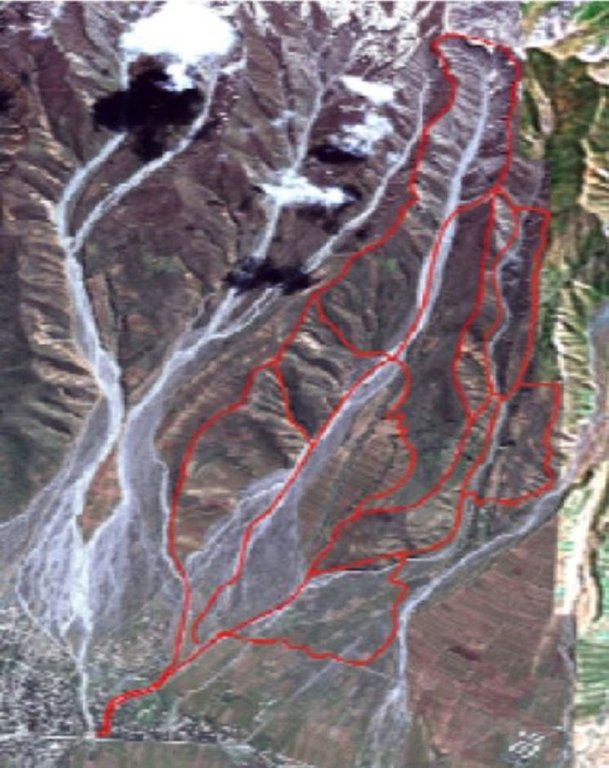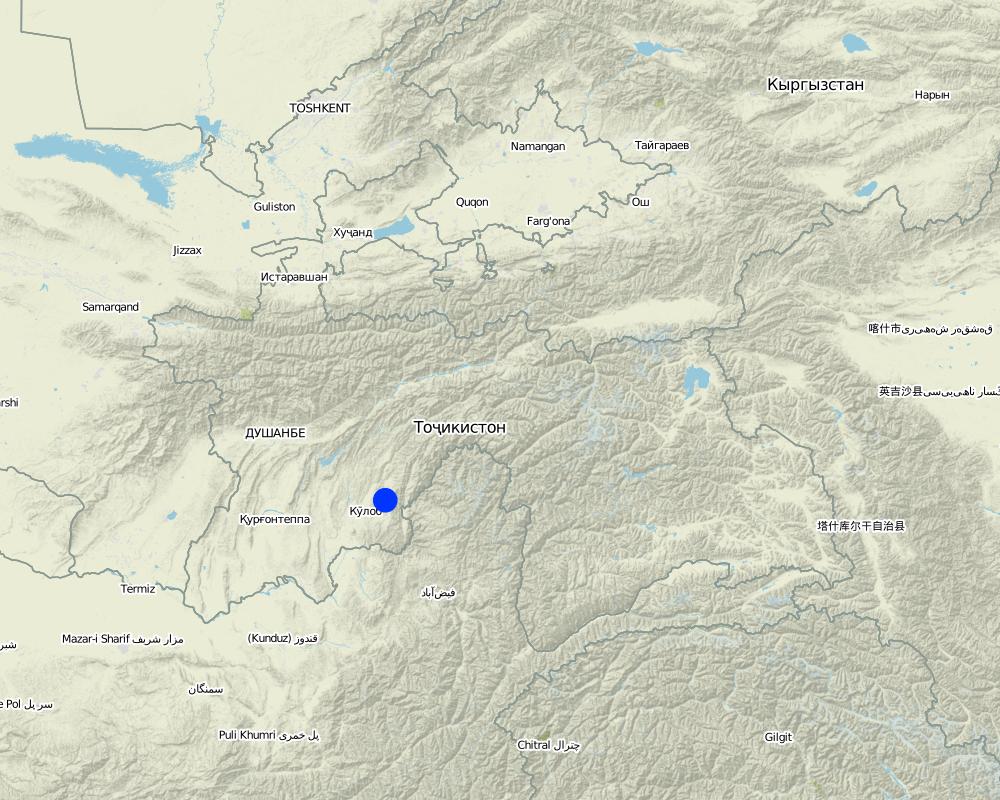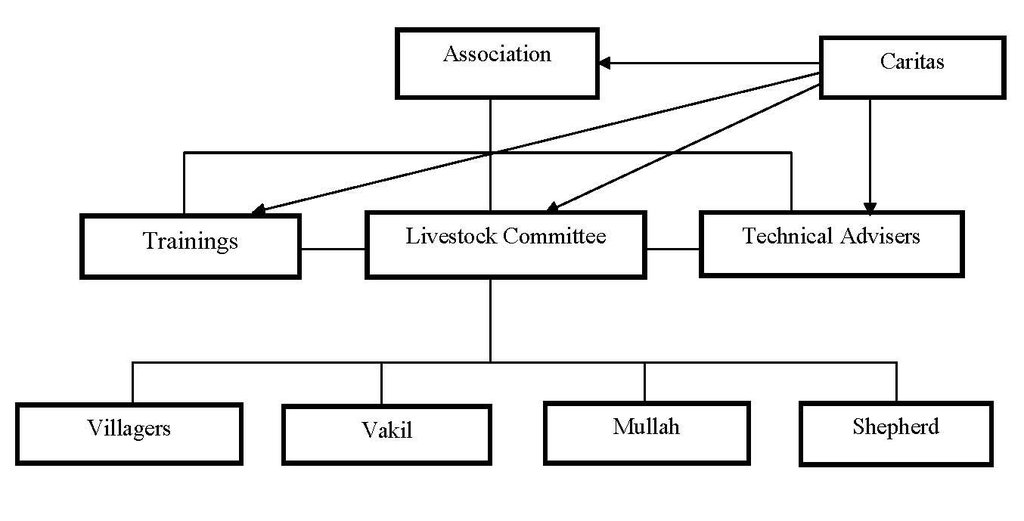Livestock Committee at Village Level [Tayikistán]
- Creación:
- Actualización:
- Compilador: Sa'dy Odinashoev
- Editor: –
- Revisores: Deborah Niggli, David Streiff, Alexandra Gavilano
Кумитаи чорврдори дар сатхи деха
approaches_2435 - Tayikistán
Visualizar secciones
Expandir todo Colapsar todos1. Información general
1.2 Detalles de contacto de las personas de referencia e instituciones involucradas en la evaluación y la documentación del Enfoque
Nombre del proyecto que facilitó la documentación/ evaluación del Enfoque (si fuera relevante)
Knowledge Management for Integrated Watershed Management and Disaster Risk Reduction (SDC / IWSM)1.3 Condiciones referidas al uso de datos documentados mediante WOCAT
¿Cuándo se compilaron los datos (en el campo)?
16/08/2010
El compilador y la/s persona(s) de referencia claves aceptan las condiciones acerca del uso de los datos documentados mediante WOCAT :
Sí
1.4 Referencia/s al/los Cuestionario(s) de Tecnologías MST
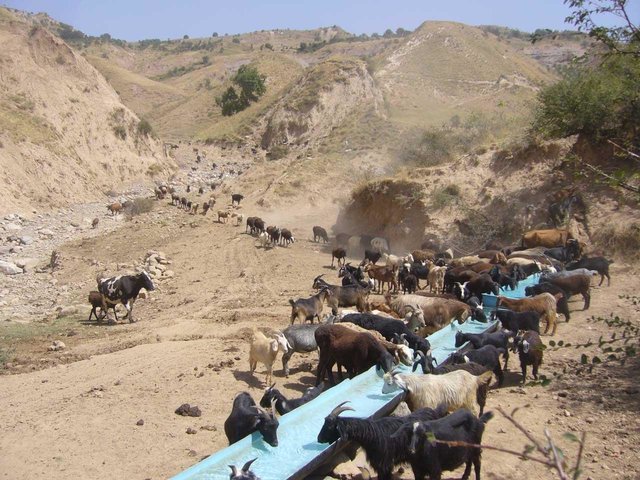
Rotational grazing supported by additional water points [Tayikistán]
After the end of the Soviet era, an increased number of livestock with less grazing land available, has led to the deterioration of the pastures, including overgrazing, reduction of plant diversity, poor livestock health and soil erosion. To tackle the problem, Caritas Switzerland together with livestock committees at village level …
- Compilador: Sa'dy Odinashoev
2. Descripción del Enfoque MST
2.1 Breve descripción del Enfoque
Livestock committees were established with the goal to improve livestock health as well as natural resource management in the watersheds where the village pastures were situated. Livestock committees in the Muminabad district are organised at village level and coordinate their activities through the registered livestock association at district level.
2.2 Descripción detallada del Enfoque MST
Descripción detallada del Enfoque MST:
Aims / objectives: This approach applied by Caritas Switzerland, aimed to improve natural resource management in the watersheds through an organised effort of livestock owners. It encourages preventive measures against soil erosion by providing incentives for beneficiaries at community level. The process is managed by the livestock committees, who represent the animal owners at village level. The committees are responsible for organising livestock owners and managing the village pastures by applying rotational grazing principles, establishment of water points and rest places, ensuring safe paths for animals and easy access to pasture lands.
Stages of implementation: The project encompasses the following steps: 1) Competitive call for project proposals to improve livestock and pasture management through villager's efforts, 2) Expression of interest from community members to participate in the competition, 3) Development of project proposals from villagers with assistance of technical staff from the implementing agency (Caritas), 4) Selection and notification of winners, confirmation of village funding commitments, 5) A village general meeting for the inception of project and laying the foundation for the livestock committee, 6) Formalisation of partnership agreement with donor (signed agreements for project implementation), 7) Project implementation transfer into livestock committee’s responsibility, 8) Technical assistance through training and workshops, monitored by the implementing agency (Caritas), 9) Strengthening of the livestock committee as a community based organisation, 10) follow up and continued activity of livestock committee through other projects and self organised activities among livestock owners.
Role of stakeholders: Various locals and village members are essential is assisting with the success of the project; The religious head (mullah) acts as a promoter of idea and mobilises the community through developing villager's interest; the village informal leader (vakil), helps to coordinate the activities; local organisations assist in informing and bringing people together for the meetings. The livestock committee consists of five members, including the appointed head shepherd. This has proven to be an effective size group. The main tasks of this committee include; mapping the pasture lands, organising rotational schemes, informing and training livestock owners of methods to improving pasture grazing, keeping villagers informed, establishing and collecting membership fees, keeping the accounts for the organisation, and application of funds (own or donor’s), develop new ideas and project proposals for further land improvement projects.
Other important information: The villagers are responsible for the labour contribution during the construction of water points or paths/roads. They pay membership fees, which cover the shepherd’s salary and the committee’s activities. They are kept informed of pasture grazing schemes, and control the performance of the committee.
2.3 Fotos del Enfoque
2.5 País/ región/ lugares donde el Enfoque fue aplicado
País:
Tayikistán
Región/ Estado/ Provincia:
Khatlon
Especifique más el lugar :
Muminabad
Map
×2.6 Fechas de inicio y conclusión del Enfoque
Indique año del inicio:
2004
Año de conclusión (si el Enfoque ya no se aplica):
2010
2.7 Tipo de Enfoque
- proyecto/ basado en un programa
2.8 Propósitos/ objetivos principales del Enfoque
The Approach focused mainly on SLM with other activities (Improve the health of livestock to water, safe roads to pasture and rest places)
To implement a responsible body to manage the common pasture land in the village, and improve conditions for livestock husbandry.
The SLM Approach addressed the following problems: Implementation of pasture projects and their sustainability. Little awareness and capacity in the field of sustainable pasture management among villagers, which hampers implementation of pasture projects.
2.9 Condiciones que facilitan o impiden la implementación de la/s Tecnología/s aplicadas bajo el Enfoque
normas y valores sociales/ culturales/ religiosos
- impiden
hierarchical society, individual villagers wait for the religious or governmental leader to make decisions
Treatment through the SLM Approach: Livestock committee to coordinate with the leaders of the society
disponibilidad/ acceso a recursos y servicios financieros
- impiden
no funds available to pay a herder
Treatment through the SLM Approach: monthly contributions from the villagers
entorno institucional
- impiden
no formal organisation for management of the common pasture land at the village level
Treatment through the SLM Approach: village livestock committees
marco de trabajo legal (tenencia de tierra, derechos de uso de tierra y agua)
- facilitan
The existing land ownership, land use rights / water rights greatly helped the approach implementation: common management of common land by the livestock committee
- impiden
unclear situation with regard to water use rights
Treatment through the SLM Approach: village negotiations are facilitated by Caritas Switzerland and the livestock committee
conocimiento de MST, acceso a apoyo técnico
- impiden
limited access to technical knowledge regarding the setup of a water distribution system
Treatment through the SLM Approach: technical advice provided by specialists from Caritas Switzerland
carga de trabajo, disponibilidad de mano de obra
- impiden
pasture improvement projects are too large for single people or families
Treatment through the SLM Approach: joint effort of the whole village
3. Participación y roles de las partes interesadas involucradas
3.1 Partes interesadas involucradas en el Enfoque y sus roles
- usuarios locales de tierras/ comunidades locales
all community members are involved
everybody can participate, disadvantaged groups have equal access
- especialistas MST/consejeros agrícolas
international specialists
technical advisors are all male
- ONG
3.2 Involucramiento de los usuarios locales de tierras/ comunidades locales en las distintas fases del Enfoque
| Involucramiento de los usuarios locales de tierras/ comunidades locales | Especifique quién se involucró y describa las actividades | |
|---|---|---|
| iniciación/ motivación | interactivo | Projects are elaborated by villagers with support of an international NGO |
| planificación | interactivo | village meetings, district meetings and proposal presentations |
| implementación | apoyo externo | Cost sharing is from 80:20 up to 50:50. The village contributes the work force, stones and seedlings. Pipes and knowledge are provided externally. |
| monitoreo y evaluación | interactivo | members of the livestock committee and international NGOs |
| Research | ninguno |
3.3 Flujograma (si estuviera disponible)
Descripción:
This organisational chart shows how the approach works at village level.
Autor:
Sady Odinashoev (Muminabad, Tajikistan)
3.4 La toma de decisiones en la selección de Tecnología(s) MST
Especifique quién decidió la selección de las Tecnología/ Tecnologías a implementarse:
- principalmente por especialistas MST en consulta con usuarios de tierras
Explique:
Decisions on the method of implementing the SLM Technology were made by mainly by SLM specialists with consultation of land users
4. Apoyo técnico, fortalecimiento institucional y gestión del conocimiento
4.1 Construcción de capacidades / capacitación
¿Se proporcionó la capacitación a usuarios de tierras/ otras partes interesadas?
Sí
Especifique quién fue capacitado:
- usuarios de tierras
Forma de capacitación:
- de agricultor a agricultor
- áreas de demostración
- reuniones públicas
Temas avanzados:
Training in pasture management, rotational grazing, natural resource management and soil erosion.
4.2 Servicio de asesoría
¿Los usuarios de tierras tienen acceso a un servicio de asesoría?
Sí
Especifique si servicio proporcionado se realizó:
- en los campos de los usuarios de tierras
Describa/ comentarios:
Key elements: theoretical and practical workshop, monitoring visits
Advisory service is quite adequate to ensure the continuation of land conservation activities; Government and other advisory service are now quite adequate to ensure the continuation of land conservation activities. The government saw the examples of good pasture management and is interested to continue with such approaches in collaboration with the livestock association.
4.3 Fortalecimiento institucional (desarrollo institucional)
¿Se establecieron o fortalecieron instituciones mediante el Enfoque?
- sí, mucho
Especifique el nivel o los niveles en los que se fortalecieron o establecieron las instituciones:
- local
Especifique el tipo de apoyo:
- construcción de capacidades/ entrenamiento
Proporcione detalles adicionales:
There were trainings for this Approach
4.4 Monitoreo y evaluación
¿El monitoreo y la evaluación forman parte del Enfoque?
Sí
Comentarios:
technical aspects were regular monitored by project staff through observations; indicators: water distribution system
management of Approach aspects were ad hoc monitored by project staff through observations; indicators: participation in committee meetings
pasture rotation aspects were regular monitored by project staff through observations; indicators: daily observations by the shepherd from the livestock committee
There were no changes in the Approach as a result of monitoring and evaluation: None
There were few changes in the Technology as a result of monitoring and evaluation: small changes on the road construction
4.5 Investigación
¿La investigación formó parte del Enfoque?
No
5. Financiamiento y apoyo material externo
5.1 Presupuesto anual para el componente MST del Enfoque
Si no se conoce el presupuesto anual preciso, indique el rango:
- 2,000-10,000
Comentarios (ej. fuentes principales de financiamiento/ donantes principales):
Approach costs were met by the following donors: International (seminars, workshops, meetings): 80.0%; local community / land user(s) (worktime, providing meeting place): 20.0%
5.2 Apoyo financiero/material proporcionado a los usuarios de tierras
¿Los usuarios de tierras recibieron financiamiento/ apoyo material para implementar la Tecnología/ Tecnologías? :
Sí
Si respondió sí, especifique el tipo o los tipos de apoyo, condiciones y proveedor(es) :
Labour input by land users was rewarded with pipes, maps and technical support
5.3 Subsidios para insumos específicos (incluyendo mano de obra)
- equipo
| Especifique qué insumos se subsidiaron | En qué grado | Especifique los subsidios |
|---|---|---|
| herramientas | shovel, spades provided by village | |
- agrícola
| Especifique qué insumos se subsidiaron | En qué grado | Especifique los subsidios |
|---|---|---|
| seedlings | from household gardens | |
- construcción
| Especifique qué insumos se subsidiaron | En qué grado | Especifique los subsidios |
|---|---|---|
| piedra | collected from field | |
- infraestructura
| Especifique qué insumos se subsidiaron | En qué grado | Especifique los subsidios |
|---|---|---|
| caminos | totalmente financiado | |
| pipes | totalmente financiado | |
Si la mano de obra de usuarios de tierras fue un insumo sustancial, ¿fue:
- recompensado con otro tipo de apoyo material?
5.4 Crédito
¿Se proporcionó crédito bajo el Enfoque para actividades MST?
No
5.5 Otros incentivos o instrumentos
¿Se usaron otros incentivos o instrumentos para promover la implementación de Tecnologías MST?
Sí
Si fuera el caso, especifique :
There were trainings for this Approach for local institutions
6. Análisis de impacto y comentarios de conclusión
6.1 Impactos del Enfoque
¿El Enfoque ayudó a los usuarios de tierras a implementar y mantener Tecnologías MST?
- No
- Sí, un poco
- Sí, moderadamente
- Sí, mucho
The soil cover improved, the milk production increased and the cows became fatter and healthier.
¿El Enfoque empoderó a grupos en desventaja social y económica?
- No
- Sí, un poco
- Sí, moderadamente
- Sí, mucho
Everybody is benefitting in the same way.
¿El Enfoque mejoró cuestiones de tenencia de tierra/ derechos de usuarios que obstaculizaron la implementación de la Tecnologías MST?
- No
- Sí, un poco
- Sí, moderadamente
- Sí, mucho
livestock committee negotiated access to water
Did other land users / projects adopt the Approach?
- No
- Sí, un poco
- Sí, moderadamente
- Sí, mucho
But other organisations and the government have shown interest in these ideas.
Did the Approach lead to improved livelihoods / human well-being?
- No
- Sí, un poco
- Sí, moderadamente
- Sí, mucho
Improvement in pastures, and milk production. Livestock has high importance as it is a large financial investment.
Did the Approach help to alleviate poverty?
- No
- Sí, un poco
- Sí, moderadamente
- Sí, mucho
With this Approach the cows become heavier and produce more milk. These animals then achieve higher prices on the market.
6.2 Motivación principal del usuario de la tierra para implementar MST
- producción incrementada
milk, meat
- incremento de la renta(bilidad), proporción mejorada de costo-beneficio
better food, less distance to walk for the animals
- carga de trabajo reducida
6.3 Sostenibilidad de las actividades del Enfoque
¿Pueden los usuarios de tierras sostener lo que se implementó mediante el Enfoque (sin apoyo externo)?
- sí
Si respondió que sí, describa cómo:
The committee and collaboration among different stakeholders are well organised and the committee is now working independently. Financial contributions per villager are quite low and villagers are willing to increase them in the future if required.
6.4 Fortalezas/ ventajas del Enfoque
| Fuerzas/ ventajas/ oportunidades desde la perspectiva del usuario de la tierra |
|---|
| financial contributions of each village household creates ownership (How to sustain/ enhance this strength: Financial contributions per villager are low and can be afforded also by poor households. This assures ongoing contributions.) |
| Fuerzas/ ventajas/ oportunidades desde la perspectiva del compilador o de otra persona de referencia clave |
|---|
| workshops in the villages (How to sustain/ enhance this strength: The livestock committees are integrated in an association and this will assure continued access to information.) |
6.5 Debilidades/ desventajas del Enfoque y formas de sobreponerse a ellos
| Debilidades/ desventajas/ riesgos desde la perspectiva del compilador o de otra persona de referencia clave | ¿Cómo sobreponerse a ellas? |
|---|---|
| Less participation of the women in the workshops | To explain to the men that women should also attend. |
7. Referencias y vínculos
7.1 Métodos/ fuentes de información
- visitas de campo, encuestas de campo
- entrevistas con usuarios de tierras
Vínculos y módulos
Expandir todo Colapsar todosVínculos

Rotational grazing supported by additional water points [Tayikistán]
After the end of the Soviet era, an increased number of livestock with less grazing land available, has led to the deterioration of the pastures, including overgrazing, reduction of plant diversity, poor livestock health and soil erosion. To tackle the problem, Caritas Switzerland together with livestock committees at village level …
- Compilador: Sa'dy Odinashoev
Módulos
No se hallaron módulos


